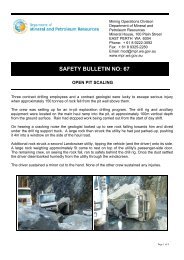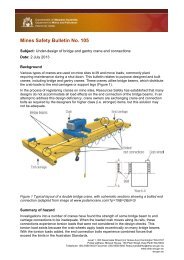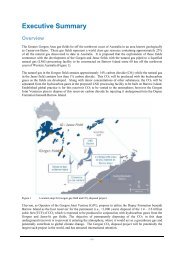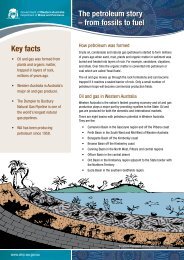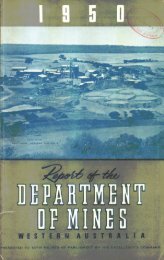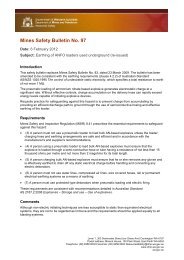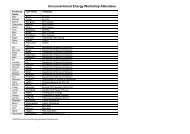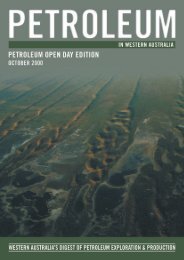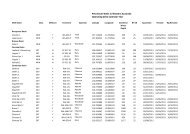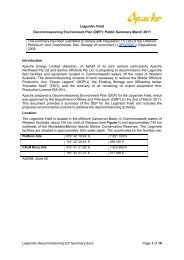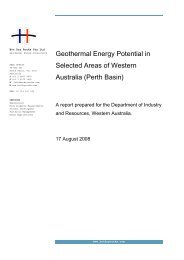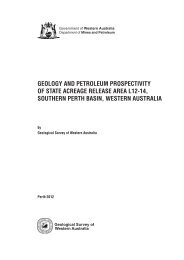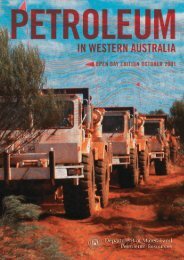IN WESTERN AUSTRALIA - Department of Mines and Petroleum
IN WESTERN AUSTRALIA - Department of Mines and Petroleum
IN WESTERN AUSTRALIA - Department of Mines and Petroleum
Create successful ePaper yourself
Turn your PDF publications into a flip-book with our unique Google optimized e-Paper software.
24<br />
PWA April Edition - Magnetotelluric Surveys<br />
Peter Kirk, <strong>Petroleum</strong> Geophysicist<br />
Peter Kirk Geophysical Consultancy Pty Ltd<br />
Of all the geophysical techniques used in<br />
petroleum exploration in Australia over the last 50<br />
years or more, the magnetotelluric or MT method<br />
has been used the least frequently <strong>and</strong> is probably<br />
the least familiar method to explorationists. There<br />
have, in fact, been five MT surveys conducted in<br />
WA, one conventional MT survey <strong>and</strong> four audio<br />
frequency MT (AMT) surveys, all <strong>of</strong> which have<br />
been conducted onshore.<br />
Although to date the technique has not resulted in<br />
any major discoveries, it has produced some<br />
interesting results <strong>and</strong> in the case <strong>of</strong> one survey it<br />
accurately predicted the results <strong>of</strong> two<br />
unsuccessful wells. It deserves to be used more<br />
frequently, particularly in areas where the seismic<br />
technique has significant problems (mainly due to<br />
shallow limestone) or where seismic acquisition is<br />
restricted due to environmental problems.<br />
The Magnetotelluric Method<br />
Magnetotellurics (MT) is a division <strong>of</strong> geophysics<br />
which studies the earth’s naturally occurring<br />
electromagnetic field <strong>and</strong> the telluric (from the<br />
Greek Tellus meaning earth) currents caused by<br />
fluctuations therein. Many researchers say that this<br />
source is “many orders <strong>of</strong> magnitude greater than<br />
the strengths <strong>of</strong> fields that can be generated with<br />
man-made sources on the surface <strong>of</strong> the earth”.<br />
The primary energy source is naturally occurring<br />
electromagnetic waves that are confined to the<br />
space between the ionosphere <strong>and</strong> the earth’s<br />
surface, these circumnavigate the globe <strong>and</strong> are<br />
consequently known as ‘spherics’. The frequencies<br />
<strong>of</strong> these waves cover a spectrum from 10 -3 Hz to<br />
10 4 Hz (about 22 octaves). The low to mid<br />
frequencies are caused by the interaction <strong>of</strong> the<br />
natural solar wind with the earth’s magnetic field,<br />
whilst the higher frequencies are generally<br />
Magnetotelluric Surveys for <strong>Petroleum</strong><br />
Exploration in Western Australia<br />
attributed to distant lightning strikes. Nearby<br />
lightning strikes, powerful man-made transmitters<br />
<strong>and</strong> highly irregular solar activity due to solar flares<br />
all produce levels <strong>of</strong> unwanted noise that prevent the<br />
recording <strong>of</strong> useful signal <strong>and</strong> also introduce<br />
spurious ‘static’ delays or depth shifts. Constant<br />
monitoring <strong>of</strong> sunspot activity or ‘space weather’ is<br />
necessary but this is greatly facilitated by the<br />
availability <strong>of</strong> reliable online data compiled by solar<br />
observatories, including the one at Learmonth in WA.<br />
Since the bulk <strong>of</strong> the useful energy is generated by<br />
the interaction with the solar wind, it is normally only<br />
possible to record during daylight hours.<br />
The primary energy source induces telluric currents<br />
just below the earth’s surface in large sheets,<br />
preferentially through conducting layers such as<br />
brine filled sedimentary rocks <strong>and</strong> certain mineral<br />
deposits. These currents flow more slowly through<br />
resistive layers such as dense limestone, volcanics<br />
such as basalt, tight non-porous rocks <strong>and</strong><br />
evaporites including salt (although salt in solution is<br />
highly conductive, solid salt is highly resistive). The<br />
currents can be readily measured as a result <strong>of</strong> the<br />
horizontal potential gradients <strong>and</strong> the horizontal <strong>and</strong><br />
vertical magnetic gradients that they produce at the<br />
surface. A modern recording instrument normally<br />
incorporates two electrical antennae horizontally at<br />
right angles <strong>and</strong> three magnetic coiled antennae<br />
horizontally <strong>and</strong> vertically at right angles. These<br />
signals may be recorded separately or the magnetic<br />
<strong>and</strong> electrical signal may be combined <strong>and</strong> recorded<br />
in stereo on digital magnetic tape. A high sampling<br />
rate is required for the higher frequency<br />
components <strong>and</strong> this is provided by modern DAT<br />
recorders, principally used by the music industry.<br />
The depth <strong>of</strong> penetration <strong>of</strong> the induced currents<br />
within the earth depends upon the frequency <strong>of</strong> the<br />
primary source with lower frequencies necessary to<br />
induce currents at greater depths. In order to<br />
measure currents kilometres below the surface, we<br />
need frequencies with periods <strong>of</strong> several minutes.<br />
Typically the length <strong>of</strong> each individual recording is<br />
20 minutes for petroleum exploration. The digitally<br />
recorded signals, which contain information for all<br />
depths, are demodulated by analogue or digital<br />
computer to final form for analysis. The recorded<br />
signal contains frequency-phase vs. amplitude<br />
information relating to the incoming field at the<br />
surface, the decaying earth carrier field, <strong>and</strong> the<br />
modulation resulting from the earth’s resistivity<br />
reflection coefficients. The former two fields are<br />
extracted using least square methods. Only the<br />
earth’s resistivity pr<strong>of</strong>ile remains as a function <strong>of</strong><br />
frequencies. The depth <strong>of</strong> investigation is a result <strong>of</strong><br />
the frequency <strong>of</strong> the data <strong>and</strong> the resistivity, <strong>and</strong> this<br />
is approximately described by the well known ‘skin<br />
depth equation’ - skin depth (m) = 500 p/f.<br />
Simplification <strong>of</strong> the “skin depth” equation is used to<br />
convert the pr<strong>of</strong>iles to depth. The result <strong>of</strong> this<br />
process is a series <strong>of</strong> electric <strong>and</strong> magnetic<br />
reflection coefficients. These are then combined to<br />
form the apparent resistivity series defined by<br />
Z = E/H as a function <strong>of</strong> depth. In addition phase<br />
values with depth are also obtained. The depths<br />
derived from the skin depth equation can then be<br />
corrected at a calibration well within the survey<br />
area. However, changes in the overburden<br />
composition, irregular variations in the earth’s<br />
magnetic field <strong>and</strong> accelerated solar activity can<br />
affect the depth accuracy. This can occur from dayto-day<br />
or from one survey area to another. These<br />
inaccuracies can be reduced by recording at a<br />
known calibration point at least every day <strong>and</strong><br />
sometimes continuously throughout the day.<br />
Sophisticated inversion algorithms can also be used<br />
to produce 2D <strong>and</strong> even 3D plots <strong>of</strong> apparent<br />
resistivity using all 5 recorded signals at each



